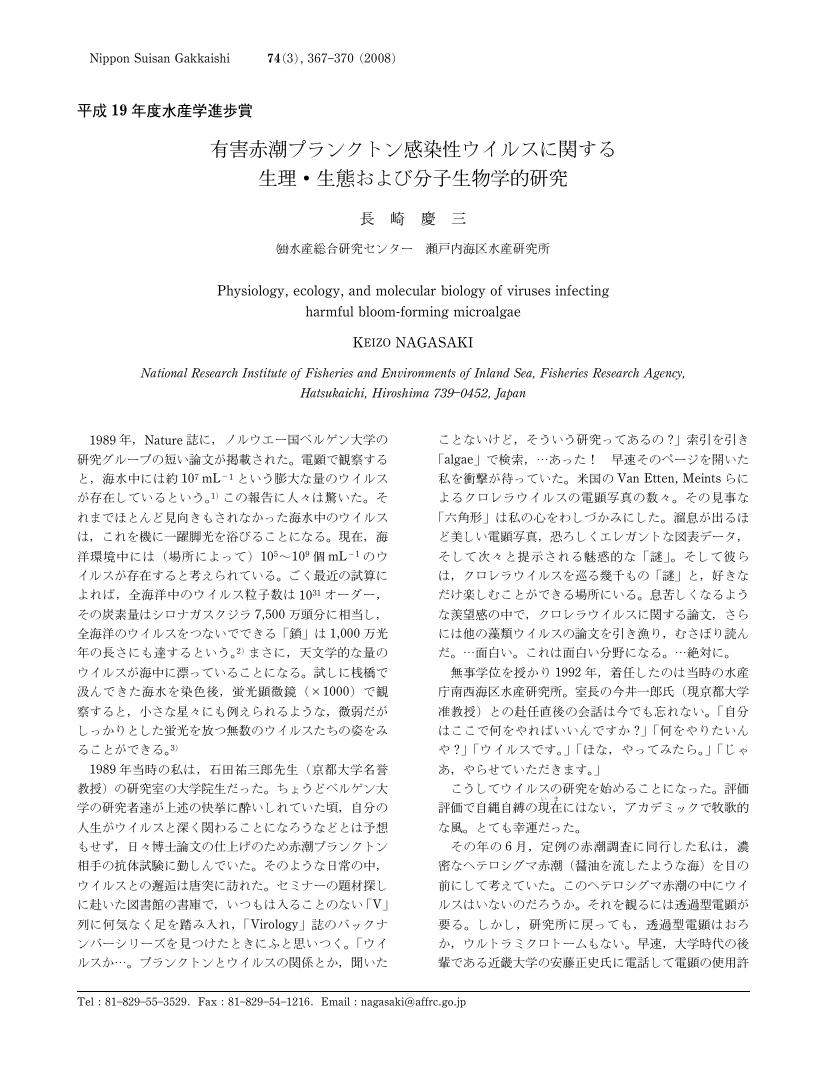4 0 0 0 OA 有害赤潮プランクトン感染性ウイルスに関する生理・生態および分子生物学的研究
- 著者
- 長崎 慶三
- 出版者
- 公益社団法人 日本水産学会
- 雑誌
- 日本水産学会誌 (ISSN:00215392)
- 巻号頁・発行日
- vol.74, no.3, pp.367-370, 2008 (Released:2008-05-28)
- 参考文献数
- 18
2 0 0 0 OA 殺藻性ウイルスによる赤潮防除の可能性
- 著者
- 長崎 慶三
- 出版者
- Japanese Society of Microbial Ecology / Japanese Society of Soil Microbiology / Taiwan Society of Microbial Ecology / Japanese Society of Plant Microbe Interactions / Japanese Society for Extremophiles
- 雑誌
- Microbes and Environments (ISSN:13426311)
- 巻号頁・発行日
- vol.13, no.2, pp.109-113, 1998-06-30 (Released:2009-10-05)
- 参考文献数
- 13
- 被引用文献数
- 3 3
To develop a practical countermeasure for eliminating harmful algal blooms (HABs), microbiological algicidity has recently been highlighted. In 1996, a virus (HaV) specifically infectious to a representative harmful bloom causing microalga, Heterosigma akashiwo, was isolated from the natural seawater. The virus has at least 4 characteristics required for biological agents to prevent H. akashiwo blooms in the natural environment: (1) HaV was isolated from “natural seawater” and experienced no artificial operation for its DNA, (2) HaV attacks H. akashiwo quite specifically, (3) HaV reproduces itself only by infecting to the host, H. akashiwo, (4) production of a small amount of HaV at a moderate price has been succeeded.
2 0 0 0 ネオウイルス学:生命の源流から超個体、そしてエコ・スフィアーへ
- 著者
- 河岡 義裕 朝長 啓造 澤 洋文 松浦 善治 川口 寧 渡辺 登喜子 鈴木 信弘 高橋 英樹 長崎 慶三 川野 秀一
- 出版者
- 東京大学
- 雑誌
- 新学術領域研究(研究領域提案型)
- 巻号頁・発行日
- 2016-06-30
(1)計画・公募研究の推進:計画・公募研究を、研究活動支援システム、領域班会議などを通じて積極的にサポートし、計画研究とともにネオウイルス学創成に目がけた研究を推進している。高度情報処理支援として、計画研究班および公募研究班に対し、スーパーコンピュータシステム・シロカネの利用による高速処理体制を構築するとともに、シロカネ上でデータ解析プログラムの連携・共有を行った。(2)領域班会議の開催:平成30年度は、4月13~15日に高知県において第4回領域班会議、また 11月11~13日に兵庫県淡路島において、第5回領域班会議を行い、 各計画・公募研究班による未発表データを含めた進捗報告を行った。会議では、活発な議論が展開され、共同研究や技術提供が活性化されるとともに、領域内の研究者間の有機的な連携が強化された。また今年度は、 テレビ会議システムを用いて、月に一度の定例会を行い、各計画・公募研究班の研究進捗の報告などを行なうことによって、領域全体の研究の推進を図った。(3)広報活動:本領域の研究活動を国民に広く発信するため、ホームページ/フェイスブックページ/ツイッターにおいて、平成30年度は26/29/169件の記事を掲載した。フォロワー数は平成29年度と比較して、フェイスブックページは160から206名、ツイッターは152から239名に増加した。また平成30年度は、領域の研究内容の概説を掲載したニュースレターを2回発行した。さらに活発なアウトリーチ活動を行なった。
1 0 0 0 殺藻性ウイルスによる赤潮防除の可能性
- 著者
- 長崎 慶三
- 出版者
- 日本微生物生態学会
- 雑誌
- Microbes and environments (ISSN:13426311)
- 巻号頁・発行日
- vol.13, no.2, pp.109-113, 1998-06-30
- 参考文献数
- 13
- 被引用文献数
- 3
Three ways of the transformation and degradation of dimethyl sulfide (DMS) by marine microorganisms or by their products are reviewed. DMS is transformed to methyl mercaptan and formaldehyde under oxic conditions by some strains of sulfur oxidizing bacteria and methylotrophs. DMS is transformed to dimethyl sulfoxide (DMSO) under oxic conditions by the bacterium which utilizes DMS as a sulfur source, ammonia oxidizers, methanotrophs, and photosensitizers produced by marine algae. DMS is transformed or degraded under anoxic conditions by some strains of methanogens and phototrophic bacteria.
1 0 0 0 OA 海水中のもっとも小さな生物因子
- 著者
- 外丸 裕司 白井 葉子 高尾 祥丈 長崎 慶三
- 出版者
- 日本海水学会
- 雑誌
- 日本海水学会誌 (ISSN:03694550)
- 巻号頁・発行日
- vol.61, no.6, pp.307-315, 2007 (Released:2013-02-19)
- 参考文献数
- 30
Since the discovery of an extremely high abundance of viruses in marine environments in late 1980's, their ecological roles and scientific importance have been of great interest. Most marine viruses are considered to be bacteriophages and cyanophages, which have significant impact on the global biogeochemical cycle. Marine viruses also include viruses infectious to eukaryotic microalgae (=algal viruses). The genomic and physiological analysis of algal viruses showed that they are remarkably different from previously known viruses; hence, poverty in the marine virus sequence database has been a problem. On the other hand, their potential importance as genetic resources has recently been highlighted. Algal viruses are also important for controlling phytoplankton dynamics, especially for bloom-forming species. In addition, marine viruses have been studied from the viewpoint of industrial applications, e.g. microbiological agents for eliminating harmful blooms and fish diseases caused by bacteria. Marine virus study is still in its infant stage; further intensive research will shed light on the importance of viruses in marine environments.
